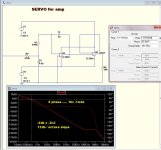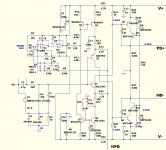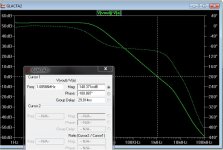CFA from japan -
I used to get the Japanese audio technology magazine called MJ. Could not read any of it but the data and schematics told the story.
Here is a commercial design of 14 years ago being written and explained from issue 8, yr 2000.
View attachment MJ 2000 CFA.pdf
THx-RNMarsh
I used to get the Japanese audio technology magazine called MJ. Could not read any of it but the data and schematics told the story.
Here is a commercial design of 14 years ago being written and explained from issue 8, yr 2000.
View attachment MJ 2000 CFA.pdf
THx-RNMarsh
Last edited:
Hmm... an intriguing circuit with some positive feedback inside the IPS, but how much? As long as the resistor values are not specified, we only can guess. 

I used to get the Japanese audio technology magazine called MJ. Could not read any of it but the data and schematics told the story.
Here is a commercial design of 14 years ago being written and explained from issue 8, yr 2000.
View attachment 395840
THx-RNMarsh
Thats the Pioneer MZ1 and M series circuit dating from 1978.
Do you have the full article, Id like a copy please.
Thats the Pioneer MZ1 and M series circuit dating from 1978.
Do you have the full article, Id like a copy please.
Hi Manso !
You can download Pioneer M-Z 1 service manual from this link : PIONEER M-Z1 Service Manual free download, schematics, eeprom, repair info for electronics
Best Regards !
Hi Manso !
You can download Pioneer M-Z 1 service manual from this link : PIONEER M-Z1 Service Manual free download, schematics, eeprom, repair info for electronics
Best Regards !
Thanks, I already have a copy, the inputstage is only shown as block diagram though.
Thanks, I already have a copy, the inputstage is only shown as block diagram though.
OK !
Yes it is inside of that AXX-002 chip ,
BTW , you can download very interesting schematic from associated Pioneer C-Z1 unit : PIONEER C-Z1 SCH SUPERLINEAR Service Manual free download, schematics, eeprom, repair info for electronics
OK !
Yes it is inside of that AXX-002 chip ,
BTW , you can download very interesting schematic from associated Pioneer C-Z1 unit : PIONEER C-Z1 SCH SUPERLINEAR Service Manual free download, schematics, eeprom, repair info for electronics
That is much more usefull, thank you.
I think I have downloaded somewhere from the net the detailed circuit of the input of M-Z1. Diamond or something, similar to Accuphase, but not sure where my copy is.
BTW i think the current on demand feature of the CFA is the reason why it seems to sonically outperform the corresponding VFA's
After someone relate it to dynamic range, I have to say that IMO this is the answer to the sound character of CFA.
After someone relate it to dynamic range, I have to say that IMO this is the answer to the sound character of CFA.
Those that relate "current on demand" to "dynamic range" don't understand at least one of these concepts.
OK !
Yes it is inside of that AXX-002 chip ,
BTW , you can download very interesting schematic from associated Pioneer C-Z1 unit : PIONEER C-Z1 SCH SUPERLINEAR Service Manual free download, schematics, eeprom, repair info for electronics
Wow, talking about "simple is better", that's quite a monster. AXX002 is not a "chip" but a module built with discretes and encapsulated in aluminum/epoxy (this is according to the text).
Wow, talking about "simple is better", that's quite a monster. AXX002 is not a "chip" but a module built with discretes and encapsulated in aluminum/epoxy (this is according to the text).
Hi Wally !
Second with you on both points !
BTW , I have no dogma about using any type of Amp inside of my audio system , CFA , VFA , Tube , SS , hybrids , class A , AB , or ......., until they sounds good to me , but honestly speaking until yet only few very simple SS CFA Amp-s was acceptable good sounding for me , but until now I have no scientific explanation for that effect , maybe this very interesting thread will give me some answers .
Best Regards !
Those that relate "current on demand" to "dynamic range" don't understand at least one of these concepts.
To help you a little..... there is a difference between dynamic range in engineering terms and more dynamic impression as heard thru listening.
Think in terms of -- it is "as if " when people describe sounds using same/similar words used in engineering.
Thx-RNMarsh
To help you a little..... there is a difference between dynamic range in engineering terms and more dynamic impression as heard thru listening.
Think in terms of -- it is "as if " when people describe sounds using same/similar words used in engineering.
Thx-RNMarsh
I thought this thread is about discussing technical aspects of the CFA, and not arbitrary re-interpretations of basic engineering concepts.
I thought this thread is about discussing technical aspects of the CFA, and not arbitrary re-interpretations of basic engineering concepts.
Yes you're right Waly. Philosophy students may argue overnight without coming to a conclusion. Wiser men tend to prefer going to sleep instead.
I think I have downloaded somewhere from the net the detailed circuit of the input of M-Z1. Diamond or something, similar to Accuphase, but not sure where my copy is.
Jay
If is possible it will be interesting to see M-Z1 detailed input circuit for sure ! ,
------------------------------------------------------------------------
but if someone have schematic of Pioneer H-Z1 headphone Amp. that will be nice to see too ! , since H-Z1 come from same M-Z & C-Z line of products I guess that follow same Non GNFB circuit architecture .
Best Regards !
Jay
If is possible it will be interesting to see M-Z1 detailed input circuit for sure ! ,
------------------------------------------------------------------------
Oooops sorry. Mine wasn't detailed either. Only showing the topology (Jfet cascaded with bjt).
My axx002 "chip" ...
I'm too cheep to buy the epoxy ... let it be thermally stable in the wind 😀 .
I decided to use the Servo (ahh , the "evil" servo - below 1). But , one jumper
in the servo section (that I will add) ... bypass the servo to use just a trimmer.
At least the servo is 0 phase from .1hz to 1mhz (no inversions).
I also used a simple (yes) ... LED CCS X 2 . (below 2 -whole contraption).
Besides having 30 or more DB PSRR , it is the same as my baseline VSSA
simulation at 1.1mhz UG. (below 3)
DID the temp-co , slightly negative from 10-50C ... led CCS cancels the
hawksford led's. SW is perfect and THD20 is 15ppm. Very good for a 2 device
"toy like" IPS - actually as good (or better)than a symasym or leach.
Off to the "races" 🙂 ....
.asc below (as well)..
OS
I'm too cheep to buy the epoxy ... let it be thermally stable in the wind 😀 .
I decided to use the Servo (ahh , the "evil" servo - below 1). But , one jumper
in the servo section (that I will add) ... bypass the servo to use just a trimmer.
At least the servo is 0 phase from .1hz to 1mhz (no inversions).
I also used a simple (yes) ... LED CCS X 2 . (below 2 -whole contraption).
Besides having 30 or more DB PSRR , it is the same as my baseline VSSA
simulation at 1.1mhz UG. (below 3)
DID the temp-co , slightly negative from 10-50C ... led CCS cancels the
hawksford led's. SW is perfect and THD20 is 15ppm. Very good for a 2 device
"toy like" IPS - actually as good (or better)than a symasym or leach.
Off to the "races" 🙂 ....
.asc below (as well)..
OS
Attachments
Hi Wally !
Second with you on both points !
BTW , I have no dogma about using any type of Amp inside of my audio system , CFA , VFA , Tube , SS , hybrids , class A , AB , or ......., until they sounds good to me , but honestly speaking until yet only few very simple SS CFA Amp-s was acceptable good sounding for me , but until now I have no scientific explanation for that effect , maybe this very interesting thread will give me some answers .
Best Regards !
I can confirm that. Roughly two decades ago I have built a simple CFA amplifier with CFP output, which had only 8dB NFB. In a few seconds after the switch on the "magic" appeared, I felt first time that is what I'm looking for. The musicians where really in my room. Could it be said that the magic doesn't depend on the degree of NFB?
Regards
egra
- Home
- Amplifiers
- Solid State
- CFA Topology Audio Amplifiers


